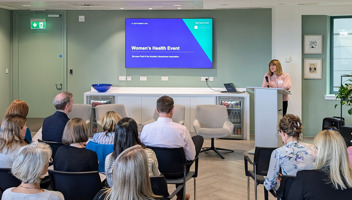Mindfulness, HIIT, work/life balance, veganism, ‘active minutes’: these are all words and phrases which we are now inundated with. Health and wellbeing is the hot topic at the moment. Health professionals, fitness experts and nutritionists are out there to provide you with every kind of service you can imagine - and the industry just doesn’t stop growing.
I didn’t follow in my family’s footsteps and become a medic; however there must be a natural tendency in my genetics towards health as on January 25th I hosted, together with my friend, Emma Windle, the inaugural Aberdeen Health and Wellbeing Festival.
Health and wellbeing has become a real passion of mine, not just in terms of maintaining my own health and wellbeing but also seeking to make changes in the wider community to embrace this. Various personal experiences together with hearing about the ongoing pressures placed on the NHS empowered me to do something in this field.
The festival was borne out of this desire to showcase what amazing resources Aberdeen has to offer, and to try and inspire, motivate and educate the local people so they can take an active role in looking after their own health and wellbeing and reduce pressure on various health services.
A particular aspect of health and wellbeing which fascinates me is that despite all our modern technology and the incredible advances we are making in terms of research and expertise we are at the same time eroding age-old practices which are good for the soul.
When was the last time you stopped and did nothing? Boredom stimulates creativity, yet children don’t know what boredom is. How much time do you spend outdoors? Can you believe that in the USA and Europe we spend around 90 per cent of our time indoors, with 65 per cent of this spent at home? Yet it has been scientifically proven being outdoors has a positive effect on our mental health.
Do you eat as a family? There is research to prove that children perform better academically when they have more meals with their family members, it also reduces destructive behaviour and strengthens family bonds. Do you mix regularly with those from a different generation? 17% of seniors in England have contact with another person less than once a week. This loneliness is only increasing as people are living longer. All of those aspects would have been a feature of life 50 years ago, but now they are disappearing for various reasons.
What does this have to do with housebuilders and development? The global wellness real estate industry was worth $134 billion in 2017 and is projected to reach $197 billion by 2022. The UK is one of the top five markets.
There is now overwhelming evidence that the importance of place quality impacts on health outcomes and therefore the case is compelling for investing in home and neighbourhood designs which contribute positively to our health and wellbeing. Up to 40% of our personal health outcomes are a function of where we live - not who we are. Some might go as far as arguing there is even an ethical responsibility to design a better place.
House design and neighbourhood design can impact on all those features I mentioned above plus countless others. I was therefore delighted to combine work with my passion when Countesswells approached us and agreed to be one of the sponsors for the festival. Countesswells felt the festival encompassed many of the values they hold close. The developers have designed this new settlement with wellness as a central theme and are hot on the heels of this billion pound industry.
Provision of outdoor community space is a priority and they have designed-in plenty opportunities for residents to get closer to nature. When you first visit Countesswells you can’t help but be impressed with this outdoor space, the Cults Burn Park was one of the first areas established and is based on the existing water course but has been expanded to include an incredible play area, orchard and areas for ecology to thrive. It is not just access to outdoors that has been thought of, they are creating a destination, a place for people to meet and socialise, with opportunities for all generations to thrive. Strengthening family life and work-life balance also features in their model - and when you speak to residents is clearly being achieved.
Most people will happily invest in a gym membership, a food box or some complimentary therapies on the basis it will improve their health. There is now also a recognition by consumers that where we live impacts our wellbeing. In fact the UK Green Building Council showed that 90% of surveyed UK buyers and renters would like a home that does not compromise their health and wellbeing and nearly 30% would be willing to pay more for this type of home. It is therefore inevitable that more and more will invest in making the right ‘place’ choice for where to live.
The industry is recognising this too. The ‘Building Better, Building Beautiful Commission Report’ published in January this year recommended having a ‘Minister for Place’ together with ‘Chief Place-Makers’ in all local authorities in England to oversee ensuring quality as communities are developed.
Although we live in an always-advancing world and new technologies and findings are making life easier all the time, we are also despite all these advances creating new health risks with sedentary living, social isolation and exclusion from nature. The real estate industry can address this.
Well thought-out house design which considers living space for social engagement and play; windows for maximised views, connections to nature and natural light to enhance our natural circadian rhythms; comfort systems to ensure heating is at a controlled level, indoor air quality is good and noise is minimised; bedrooms which promote healthy sleep; and well-thought-out storage to promote stress free functional living can all aid our wellbeing.
A healthy neighbourhood needs connectivity; to be able to create a community to promote social inclusion but also give a sense of security; provide green space to improve physical and mental health; give access to education, work opportunities and healthcare; as well as being built to be resilient.
There does appear to be a well-justified business case for providing healthier homes and neighbourhoods, and this trend is only going to go up as more and more people are made aware of the links between ‘place’ and their wellbeing. The industry is growing at a rapid rate and in addition to developers benefiting from this wellbeing boom the value to the economy could be huge.
If you consider the cost to the economy of mental ill health is more than £94 billion every year, and the cost to the NHS alone of physical inactivity is around £1 billion per year, then the case is really already made to start making improvements in the design of our homes and neighbourhoods.
We were thrilled at our Festival to showcase all that Aberdeen has to offer, including the Countesswells community, to improve our population’s health and wellbeing. The feedback has been so positive we can’t wait to get stuck into the next event and continue to inspire those around us.
Whether you are in the housebuilding industry or not, what could you do to help your community’s health and wellbeing?
Related News, Insights & Events

The Windsor Framework Agreement – What does it mean for the trade of medicinal products across the UK?
On the 1st of January 2025, provisions of the Windsor Framework relating to the regulation, licensing, labelling and wholesale dealing of medicinal products in the UK became effective.

Stop before you start(up): Have you considered your IP?
If you are in the process of or considering starting a business, be sure to not fall victim to the misconception that intellectual property (IP) is only a consideration for corporate giants.

How Scotland’s life sciences sector can lead the way on women’s health
Despite being over half the population, women’s health needs have been historically overlooked.





